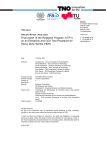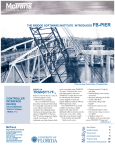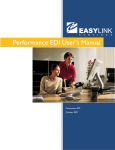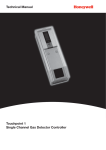Download Hardware-In-The-Loop - Mechanical Engineering
Transcript
Hardware-In-The-Loop On-ramp Simulation Tool to Debug and Test the Universal Ramp Metering Software Rene O. Sanchez, Roberto Horowitz and Pravin Varaiya Abstract— An on-ramp simulation system that can be used to debug and test the Universal Ramp Metering Software (URMS) is presented. The tool includes a simple car following microscopic traffic model for the on-ramp and a Controller Interface Device (CID), which interfaces a standard personal computer with a 2070 traffic controller. The CID consists of the low cost and commonly available National Instruments (NI) USB-6501 24-Channel Digital I/O device and a basic circuit that interfaces the 5-Volt TTL logic from the Digital I/O board to the 2070 controller. The resulting hardware-in-the-loop simulation tool systematically reads the phase states from the controller and changes detector states based on the cars trajectories as displayed on the on-ramp simulator. With this tool it is possible to check the performance of the 2070 controller running the URMS as if the traffic controller was operating on a standard on-ramp managed by Caltrans. Finally, the real-time nature of this tool is discussed based on a quantitative analysis of the simulator performance running on the Windows XP operating system. I. INTRODUCTION A hardware-in-the-loop simulation (HILS) system was developed as a tool to assist in the completion of a ramp metering field test. This field test has been proposed in order to implement queue control on the Hegenberger Rd. loop onramp to 880 southbound in the Caltrans Bay Area District (D4) to study its effect in minimizing queue and mainline density oscillations and enhancing performance. This will be accomplished by using a 2070 traffic controller running a modified Universal Ramp Metering Software (URMS), which is a recently developed program that allows the 2070 traffic controller to function as a ramp metering controller for use throughout California[1]. To prevent on-ramp queues from spilling over into surface streets and interfering with the street traffic, the queue length must be regulated. If the queue length could be measured, an asymptotically stable PI regulator can be designed to stabilize the closed loop queue dynamics [2]. However, the PI regulator needs the current queue length as its feedback signal, which unfortunately is not available in the field. For the field test, two different queue-length estimation methods will be evaluated. The first method is a queue-length estimator based on a simplified model for the driving behavior of a vehicle that is approaching the end of the queue: the vehicle decelerates at a constant rate from its cruising speed, until it stops. By measuring speed upstream of the on-ramp, using R. O. Sanchez is with the Department of Mechanical Engineering, University of California, Berkeley. [email protected] R. Horowitz is a Professor at Department of Mechanical Engineering, University of California, Berkeley. [email protected] P. Varaiya is a Professor at Department of Electrical Engineering, University of California, Berkeley. [email protected] dual loop detectors, it will be possible to estimate the queuelength[2]. The second method estimates the queue-length using a vehicle re-identification algorithm [3], [4]. This scheme is based on matching individual vehicle signatures obtained from Sensys wireless sensor arrays placed at the two ends of the on-ramp. Before deploying a 2070 controller with a modified URMS in the Hegenberger on-ramp, it must be thoroughly debugged. In addition, the modified software must be tested and approved by D4 engineers before it can be used on the field. The unmodified URMS software has already been debugged and tested by Caltrans engineers before its release for preliminary testing in the field using a traditional traffic controller suitcase tester device (see Figure 1). However, one of the main drawbacks of this tester is the need to manually operate mechanical switches to simulate loop detector signals. This debugging and testing approach becomes difficult and sometimes inappropriate when coordination of signal actuation is required, as will be the case for the field test. To debug and test the modified URMS, it will be necessary to recreate the dual detector signals used to measure vehicle speed upstream of the on-ramp, with good accuracy. For this reason, it was decided to design and build a hardwarein-the-loop simulation system to replicate in real-time the Hegenberger on-ramp detector signals. Fig. 1. Traffic controller suitcase tester used to evaluate the URMS II. HARDWARE-IN-THE-LOOP SIMULATION The hardware-in-the-loop simulation (HILS) concept has been used to create a simulation tool to test the URMS running on a 2070 controller. A particular feature of this type of architecture is that the traffic simulation model does not implement any control logic, instead it controls traffic flow in the simulation based on the phase states produced by the traffic signal control equipment. Simultaneously, the traffic signal control equipment uses the detector signals generated by the simulation to update its control logic (see Figure 2(a)) [5]. HILS has been used in the past to interface with traffic signal control equipment for testing purposes; however, previous systems focused on testing intersection control software. The simulation time step used in these systems is on the order of seconds, and equipment is used primarily to simulate loop detector signals used by traffic controllers to determine car presence and a rough estimate of occupancy [6], [7]. The tool presented in this paper is primarily designed to generate, through simulation, traffic detector signals for an on-ramp/freeway system (see Figure 3(b)) with sufficient resolution to allow the 2070 controller to accurately calculate volume, occupancy, and speed. The HILS system presented in this paper has three basic components: 1) a controller interface device (CID), 2) a software interface module, and 3) a microscopic simulation engine. A description of each component is presented below. a) Computer 2070 Controller Controller Interface Device (CID) The custom made circuit was designed to interface the 5Volt TTL logic from the digital I/O board to the 2070 controller. This circuit was built using a modular IC breadboard socket, SN706 TTL hex inverter buffers/drivers with opencollector high-voltage outputs, one 7805A voltage regulator, and a 12-Volt power supply. Two main goals of the CID design stage were portability and low cost. The portability was ensured with the use of a small USB DIO board that can be used in most personal computers. The low cost was achieved by using one of the cheapest data acquisition boards on the market. The components to build the CID presented in this paper cost less than 200 U.S. dollars. B. Software Interface Module The software interface model provides the linkage between the CID and the traffic simulation program. The NI USB6501 board used to build the CID comes with drivers that can be used to develop customized applications using NI LabVIEW. These drivers serve as the software interface module, and do not require any modification when used in the HILS tool. Detector States Detector States C. Microscopic Simulation Engine Phase States Phase States b) 2070 Controller running the URMS CID Computer running Simulation Tool Fig. 2. (a) On-ramp simulation tool architecture (b) On-ramp simulation tool setup The simulation engine was developed using the NI LabVIEW development environment. Before deciding to create a custom traffic microscopic simulator, commercial simulator packages were considered. However, the time steps used in these simulators were not low enough for the resolution desired for this application, e.g. CORSIM uses a 1 second time step while VISSIM can not go lower than 100 milliseconds. This limitation was one reason for developing a microscopic simulation specifically for an on-ramp/freeway system with a time step between 1 and 10 milliseconds. Another reason was to have the flexibility to customize the simulation engine to complement some features of the URMS, e.g. configuration and testing menus. A. Computer Interface Device (CID) This device provides the interface from the 2070 traffic controller to the personal computer running the traffic simulation. The CID has two main elements: 1) the NI USB-6501 device and 2) a custom electronic circuit. The NI USB-6501 is a portable digital Input/Output device, which provides data acquisition and control capabilities. With plug-and-play USB connectivity, the NI USB-6501 is very versatile and can be used in most personal computers. The NI USB-6501 has 24 single-ended digital lines, which comprise three DIO ports. In this tool, two ports are configured to generate detector signals and one port is used to read the phase states output from the controller. This device was chosen because of its low price, portability, and because when used with LabVIEW, it provides a straightforward procedure to interface with the simulation engine. Signals can be sent and received using LabVIEW standard functions that can easily be accessed from the simulation. a) b) Traffic Light State (available from 2070 Controller) LO TO Q On-ramp Demand (data available from D4) P D Legend: T1 L1 T2 L2 T3 L3 T4 L4 Detection Station (data available from PeMS) L = Leading Detector T = Trailing Detector P = Passage Detector D = Demand Detector LO = On-ramp Leading Detector TO = On-ramp Trailing Detector Q = Queue Detector Fig. 3. (a) Hegenberger Rd. loop on-ramp to 880 southbound (b) Hegenberger on-ramp/mainline layout used for the simulation tool III. THE MODEL In order to simulate the Hegenberger on-ramp/freeway system (see Figure 3(a)), it was necessary to use a simplified layout that would capture the detector location and the ramp characteristics. Figure 3(b) shows a simplified configuration of the Hegenberger onramp/freeway system that follows the NTCIP typical on-ramp layout as close as possible [8], which is also the standard configuration used in the URMS. The ramp layout had to be slightly modified to incorporate dual detection for queue-length estimation. A traffic controller operating on an on-ramp in California is usually programmed to collect data from the on-ramp detectors, set the traffic light phase states, and collect mainline detection stations data (sometimes multiple mainline detection stations). In order for the simulation tool to generate the signals that a traffic controller would encounter in the field, it was decided to simulate traffic conditions on the Hegenberger on-ramp/mainline system with two completely different models: 1) a constant velocity microscopic mainline traffic model and 2) a simplified car following on-ramp traffic model. The 2070 controller is able to read the detector states set by both models and can update the on-ramp simulation metering rate (phase states). With this approach, on-ramp traffic conditions do not have any effect on the mainline freeway simulation. However, simulated mainline traffic conditions may have an effect on the on-ramp simulation depending on the ramp metering algorithms implemented in the URMS. The simulation tool was designed in this way in order to test traffic responsive ramp metering algorithms like ALINEA [9], where mainline traffic conditions read by the controller are used to set the metering rate at the on-ramp. It should be noted that this tool only allows testing the open loop behavior of ramp metering algorithms, as there is no interaction of the on-ramp and the mainline model. Fig. 4. (left) Freeway layout (right) On-ramp layout A. Freeway Mainline Model A constant velocity microscopic mainline traffic model was used to model vehicle trajectories on the mainline. In this model, the cars of a given freeway lane travel at the same speed, and their position is updated every simulation period. The car trajectories start at the beginning of the freeway segment, and end when the car reaches the end of the freeway segment, given by the user-specified freeway length (see Figure 4 (left)). The cars are generated based on the flow specified for every calculation interval. The URMS software calculates aggregates of mainline data every 30 seconds. For this reason, parameters for a given lane can be updated every 30 second calculation interval in the simulation. However, the calculation interval should be set taking the data used to feed the simulator into account. For example, if PeMS [10] data are used, the calculation interval should be set equal to the time granularity used in the data set. The model for the freeway can be very simple because the main objective of this part of the tool is to generate loop detector signals that the controller can read to calculate aggregate values for each calculation interval, and use these aggregate values as the input for traffic-responsive ramp metering controllers. Fig. 5. Mainline loop detectors actuation B. On-ramp Model A simplified car following traffic model, based on [11], was used to simulate vehicles on the on-ramp. This is a simple model specifically conceived for a homogeneous highway in which the nth vehicle follows the same trajectory as the (n-1)th vehicle except for a translation in space and time. It was necessary to incorporate the ramp metering traffic signal into the model, which can be considered as an inhomogeneity, by specifying rules of how vehicles react to the signal. The rules that were specified are: 1) a car in front of the traffic light must stop when the light is red, and 2) only a predetermined number of cars can advance per green phase. It was decided to use this model because it is simple but captures dynamics that are important for an accurate generation of detector signals. There is a particular interest in testing algorithms that use vehicle speed close to the onramp entrance to estimate queue-length. This model allows for changes in speed based on driver behavior parameters and the presence of vehicles ahead. With this model it is also possible to introduce queue dynamics in the simulation, a feature necessary for the accurate generation and timing of on-ramp detector signals. For the simulation, it is necessary to know parameters related to the length of the on-ramp, the length of the loop detectors, and the position of the loop detector with respect to the ramp entrance. All these parameters can be specified using the simulator on-ramp layout menu, as shown in Figure 4 (right). For the Hegenberger on-ramp, these parameters were obtained from Goolge EarthT M and [12]. C. Vehicle/Loop Interaction The loop detector signals generated by the simulation tool are actuated based on vehicle positions. Both simulations have the location of the loop detectors with respect to the beginning of the freeway segment and the beginning of the on-ramp, respectively. When any of the data points representing a vehicle is on the detection zone specified by the location of its leading and trailing edge, the detector signal is triggered. The interaction between loop detectors and cars occurs in real-time. Whenever the display in the simulator shows an active detector, the detector signal read by the controller for that specific detector is active as well (see Figure 5). This is a desired feature for a debugging tool, since it helps to visually identify what is the state of each signal going into the controller. In order to recreate the signals generated in a real onramp/freeway system more realistically, three types of vehicles can be generated in the simulator: 1) cars, 2) pickups, and 3) trucks. Each vehicle has an independent length, shape, and probability of occurrence. The particular shape of each car can be observed in Figure 5. used in conjunction with the URMS Input File Test utility, it is straightforward to check if the simulation and the URMS signal assignments match and if the detector states are read properly by the 2070 controller. IV. SIMULATION TOOL The simulation software was developed using the NI LabVIEW development environment. This software is composed of four elements: 1) the 2070 controller input configurator, 2) the 2070 controller output configurator, 3) a freeway simulator, and 4) an on-ramp simulator. When the program is run, the user can decide if any configurator will be used. If the configuration process for the inputs or outputs is skipped, the configuration stored in the computer will be used by the program. After the configuration process is completed or bypassed, the on-ramp and freeway simulations start. In the following, each component of the software is described. Fig. 7. 2070 Controller Output Configurator B. 2070 Controller Output Configurator The 2070 controller output configuration application was developed to match the URMS configuration convention. The diagram used in the configurator to show the output file current assignments (see Figure 7) is the same as that used in [1] to describe the physical output number for each output file slot for a Model 334 cabinet. An output configurator was implemented in order to map every phase indication used in the simulation to the corresponding phase in the 2070 controller, as recommended in [5]. In this configuration application, it is possible to independently read the phase of each active output. When this feature is used in conjunction with the URMS Output File Test, Output Signal Test, and/or Lights Test utilities, it is easy to check if the simulation and the URMS output signal assignments match and if the phase states are read properly by the simulation. C. Freeway Simulator Fig. 6. 2070 Controller Input Configurator A. 2070 Controller Input Configurator The 2070 controller input configuration application was developed to match the URMS configuration convention. The diagram used in the configurator to show the Input File current assignments (see Figure 6) is the same as that used in [1] to describe the physical input number for each input file slot for a Model 334 cabinet. An input configurator was included in this tool, because it is necessary to map every detector used in the simulation to the corresponding detector in the 2070 controller, as recommended in [5]. In this configuration application, it is possible to independently change the state of each active input. When this feature is The constant velocity microscopic mainline traffic model described earlier is implemented in the freeway simulator application. There are three components associated with this part of the simulation: 1) the freeway simulation user interface, shown in Figure 8, 2) a freeway layout menu (see Figure 4(left)), and 3) a vehicle menu. The simulation interface is used to observe the movement of vehicles through the defined freeway segment. With this interface, information related to the simulation can be accessed and it is possible to set and modify freeway lane parameters independently. In the freeway layout menu, the dimension of the mainline segment, the detector location, and the detector separation can be set. Finally, the vehicle menu is used to determine the properties of the three types of vehicles present in the simulation. The vehicle parameters for the mainline simulation can be different from those used on the on-ramp simulator. Fig. 8. Freeway simulator interface D. On-ramp Simulator The simplified car following traffic model described earlier is implemented in the on-ramp simulator. There are three components associated with this application: 1) the on-ramp simulation user interface, shown in Figure 9, 2) a freeway layout menu (see Figure 4(right)), and 3) a vehicle menu. The simulation interface is used to observe the movement of vehicles through the on-ramp. This component also displays information related to the simulation, including the phase state output by the 2070 controller. Using this interface, it is also possible to set and modify simulation parameters. In the on-ramp layout menu, the dimension of the onramp segment, the detectors location, their length, and their separation can be set. Finally, the vehicle menu is used to determine the properties of the three types of vehicles present in the on-ramp simulator. Fig. 9. On-ramp simulator interface V. BENCHMARKING This tool was designed to simulate traffic conditions on an on-ramp/freeway system and update vehicle positions and detector states in real-time. In the context of this project, real-time means that the HILS system should simulate the displacement of vehicles, check if the vehicles are on a detection zone, and update detector states with a time equal or less than the actual time it would take vehicles to travel the same displacement on a real on-ramp/freeway system. Furthermore, it is desired to achieve the smallest possible simulation time step (∆t) in order to increase the resolution of the detector signals sent to the 2070 controller. The real-time nature of the hardware-in-the-loop simulation (HILS) tool is limited by the performance of the Windows XP operating system, which only permits a 1 ms time resolution. Even though an actual HILS simulation step (∆tactual ) may take less than 1 ms, this time is usually larger, since Windows XP does not have sufficient realtime capability to effectively implement such precise timing [5]. To compensate for this limitation, the simulation was designed so that the timing of the simulator would be based on three time stamps: 1) a reference time stamp obtained at the beginning of the simulation run (to ), 2) a time stamp recorded in the (i-1)th simulation step (ti−1 ), and 3) a time stamp obtained in the current (ith) simulation step (ti ). To update any quantity that needs the total simulation time, the difference between ti and to is used. For quantities that need the time increment between the (i-1)th and the ith simulation steps, e.g. to calculate position increments, the difference between ti and ti−1 is used. This configuration helps maintain accurate simulation timing even when variations in the actual simulation step execution time (∆tactual ) occur. Offsets introduce by having ∆tactual 6= ∆t at the ith simulation step can be removed at the (i+1)th simulation step. In order to show that the HILS system is a reliable tool to debug and test the URMS, it was important to quantify the uncertainty introduced by not developing this tool on a real time operating system environment. As a result, a benchmarking procedure was used to characterize the realtime nature of the software. 8 simulation runs, of 60,000 simulation steps each, were executed using different desired time steps (∆t). The actual time step (∆tactual ) was recorded for each simulation step and stored into a file. These data were used to determine the time reliability of this tool as a function of ∆t. The results of the analysis are presented in Table I and show that ∆tactual for at least 97.5% of the steps is within one millisecond of ∆t. The worst performance is observed when ∆t = 1 ms. As ∆t increases, the percentage of ∆tactual that are within one ms of ∆t increases, while the standard deviation decreases. Based on Table I and Figure 10, choosing ∆t = 2 ms provides the time resolution needed for the HILS tool while introducing an acceptable error on the generation of the detector signals. In order to quantify the effect of time uncertainty on the detector signals, a worst case scenario analysis for ∆t = 2 ms was performed. The shortest signals generated by the simulator, which are also the most affected by the time uncertainty, are those of the smaller cars traveling over a loop detector at the speed limit. There is a speed limit specified for the freeway and one for the on-ramp. Assuming that CID and a 2070 controller running the URMS. The system was developed to assist in the debugging and testing process involved with the release of a URMS version for deployment in the field. Since this tool was specifically tailored for a 2070 controller running the URMS, it allows for an easy configuration of the system and a user-friendly interface that matches or complements some of the URMS debugging features. The paper also presented an analysis of the realtime nature of the simulator that shows that for all practical purposes, Windows XP limited real-time capabilities do not affect the performance of the HILS tool. Future research involves adding more versatility to the tool and enabling communication with the controller in order to increase synchronization. Fig. 10. Histograms of ∆tactual for multiple simulation runs (60,000 iterations each) using different ∆t ∆tactual = ∆tmax , the propagation of the maximum error, of 16 ms, is shown in Table II. Based on the data collected from the benchmarking procedure, the uncertainty propagated to detector signals generated by the simulators is within ± 16 ms, which when used by the 2070 controller to calculate velocity would yield a ± 6.4 mph uncertainty for the freeway simulator and a ± 1.5 mph uncertainty for the on-ramp simulator. The ± 6.4 mph uncertainty in the mainline speed computations may seem significant. However, it will not considerably affect the aggregate mainline speed since it is calculated as an average over a URMS calculation interval. For any practical purposes, the ± 1.5 mph uncertainty will not affect the velocity estimation on the on-ramp. 1 2 3 4 5 10 25 50 ∆t ∆taverage σ ∆tmax ∆tactual = ∆t±1 ms ms ms ms ms ms ms ms 2.00 2.09 3.26 4.19 5.20 10.25 25.34 50.93 0.506 0.465 0.553 0.426 0.492 0.476 0.478 0.271 17 17 17 17 18 23 30 56 97.63% 98.99% 99.20% 99.60% 99.69% 99.76% 99.96% 99.91% TABLE I B ENCHMARKING RESULTS OF 60,000 SIMULATION STEP RUNS FOR DIFFERENT ∆t. On-ramp Freeway Vmax tactuation tcontroller Vcontroller 40 mph 80 mph 408.32 ms 204.16 ms 408.32 ± 16 ms 204.16 ± 16 ms 40 ± 1.5 mph 80 ± 6.4 mph TABLE II S IMULATED LOOP DETECTOR SIGNAL UNCERTAINTY FOR ∆t = 2 ms, Ldetector =1.8 m and Lcar = 5.5 m . VI. CONCLUSION This paper presented a hardware-in-the-loop on-ramp evaluation system for the URMS, which consists of a personal computer running an on-ramp microscopic traffic model, a Symbol Name Unit ∆t ∆taverage ∆tactual ∆tmax σ Vmax Ldetector Lcar tactuation tcontroller Vcontroller desired simulation time step average simulation execution time actual simulation execution time maximum recorded time step standard deviation maximum velocity used in simulation loop detector length average regular car length theoretical detector actuation time based on Vmax detector actuation time recorded by 2070 controller velocity calculated by 2070 controller ms ms ms ms ms mph m m ms ms mph TABLE III L IST OF S YMBOLS R EFERENCES [1] D. Wells and E. Torizno, “URMS: Universal Ramp Metering Software User Manual,” tech. rep., Traffic Operations, Caltrans. Version 1.07, 2008. [2] X. Sun, Modeling, Estimation, and Control of Freeway Traffic. PhD thesis, University of California, Berkeley, 2005. [3] K. Kwong, R. Kavaler, R. Rajagopal, and P. Varaiya, “A practical scheme for arterial travel time estimation based on vehicle reidentification using wireless sensors,” in Transportation Research Board 89th Annual Meeting, 2009. [4] K. Kwong, R. Kavaler, R. Rajagopal, and P. Varaiya, “Arterial travel time estimation based on vehicle re-identification using wireless sensors,” Submited for publication to TRC. [5] D. Bullock, B. Johnson, R. B. Wells, M. Kyte, and Z. Li, “Hardwarein-the-loop simulation,” Transportation Research Part C: Emerging Technologies, vol. 12, no. 1, pp. 73 – 89, 2004. [6] Z. Li, B. Johnson, A. Abdel-Rahim, and M. Kyte, “Hardware and software design of an automated testing tool for traffic controllers,” in Intelligent Transportation Systems Conference, 2006. ITSC ’06. IEEE, pp. 1525–1530, Sept. 2006. [7] E. Kwon, S. Kim, and T. M. Kwon, “Pseudo real-time evaluation of adaptive traffic control strategies using hardware-in-loop simulation,” in Industrial Electronics Society, 2001. IECON ’01. The 27th Annual Conference of the IEEE, vol. 3, pp. 1910–1914 vol.3, 2001. [8] “NTCIP 1207:2001, v01.17. National Transportation Communications for ITS Protocol. Object Definition for Ramp Meter Control (RMC) units,” tech. rep., ASSHTO/ITE/NEMA, 2001. [9] H. Hadj-Salem, J.-M. Blosseville, and M. Papageorgiou, “Alinea: a local feedback control law for on-ramp metering; a real-life study,” pp. 194–198, May 1990. [10] PeMS, “PeMS website,” url:http://pems.eecs.berkeley.edu, accessed 2/3/2009, 2009. [11] G. F. Newell, “A simplified car-following theory: a lower order model,” Transportation Research Part B: Methodological, vol. 36, no. 3, pp. 195 – 205, 2002. [12] T. O. Program, “Ramp Meter Design Manual,” tech. rep., California Department of Transportation, 2000.
















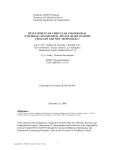


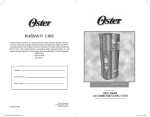
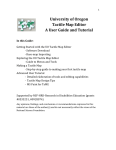
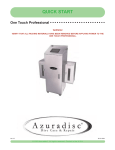
![Registry Manual []](http://vs1.manualzilla.com/store/data/005750489_1-c8586633e9f35db1a00a4874731a3151-150x150.png)
